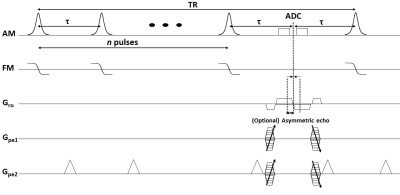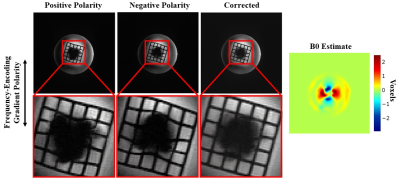5019
Fast Distortion-Free Structural Imaging near Metal at 7T1Center for Magnetic Resonance Research and Department of Radiology, University of Minnesota, Minneapolis, MN, United States
Synopsis
Clinical MRI sequences for imaging near metallic implants are mainly multi-spectral approaches, with fast spin-echo acquisitions and large acceleration factors to achieve clinically relevant scan times. The authors previously reported a broadband, low flip angle method at 1.5T and 3T to image with large field inhomogeneity, such as near metallic implants, quickly relative to non-spatially selective multispectral approaches. Herein, modifications to the previous approach, dual polarity missing pulse steady-state free precession, are presented which achieve high spatial resolutions at 7T with a large 3D FOV in ~5 minutes.
Purpose
A small number of sequences are currently available for MR imaging near metallic implants in a clinically relevant scan time (1-3) due to the large induced field inhomogeneities. While the accuracy and efficiency of dual polarity missing pulse steady-state free precession (MP-SSFP) has previously been demonstrated at 1.5T and 3T, the scan time was ~9 minutes, even when using an acceleration factor R=3x2. The MP-SSFP sequence has been modified to acquire both frequency encoding gradient polarities in one spin echo, with an optional asymmetric gradient echo to decrease the minimum TR of the sequence for further decreases in scan time (see Fig. 1), to 5.38 minutes.Methods
The Missing Pulse Steady-State Free Precession (MP-SSFP) (4) sequence was used, whereby a train of n small-flip angle pulses are applied to achieve a steady-state. Data are acquired in place of the n+1 pulse, where an echo forms. This sequence achieves radiofrequency (RF) refocusing with low peak amplitude. The dual polarity encoding was implemented such that acquisition of the same phase encoding line for each gradient polarity was separated only by the time taken to reverse the gradient polarity, in contrast to (5), wherein a full TR separated the acquisition of the same line for both polarities. The optional asymmetric echo has the benefit of decreasing minimum TR and bringing the time where the center of k-space is acquired closer to the center of the spin/stimulated echo created by MP-SSFP at the expense of acquiring an asymmetric k-space along the frequency encoded direction. The displacement field was estimated by aligning the intensity-corrected, resampled magnitude images resulting from the opposing gradient polarities, parameterizing the displacement in terms of 3D B-splines (6).Phantom experiments were performed on a 7T Siemens Magnetom system using a 32-channel receive head coil. An agar phantom was used with one stainless steel and one titanium screw embedded inside. The MP-SSFP sequence used n=3 pulses, TR=34ms, and 1780 Hz/pixel receiver bandwidth with prospective in-plane undersampling R=2x2, 6/8 Partial Fourier (PF) in-plane and through-plane. Hyperbolic secant (7) pulses were used, with time-bandwidth product 20, 500µs duration, 40kHz bandwidth, and 10˚ flip angle. The field-of-view (FOV) was 256x256x256 mm3 with 1mm isotropic resolution, and total scan time of 5.63 minutes.
The DICOM images were used as inputs for the offline distortion correction algorithm which used 6mm spline knot spacing to estimate the displacement field. The distortion correction algorithm took 58s to run.
Results
A comparison of the distorted images from an exemplar 2D cross section to the corrected image are given in Fig. 2, along with the estimated displacement field. The asymmetric echo option was not used in this study. The geometric and intensity distortions are clearly corrected, but there is too little spatial encoding closer to the metal to accurately reconstruct the image, due to large intrinsic field gradients.Discussion
The sequence presented here offers the possibility of imaging near metallic implants at 7T with manageable RF heating, which has limited the ability to image in this scenario at ultra high field thus far.(8)A common problem with PF occurs in regions with rapid image phase variation, due to the inability to correct such phase variation with the symmetrically sampled portion of k-space. Hence, a systematic analysis of the effects of increasing echo asymmetry on achieved spatial resolution vs. nominal spatial resolution is planned. Furthermore, examination of the effects of different PF reconstruction methods is necessary.
Compared to 1.5T & 3T, imaging near metallic implants at 7T requires substantially higher bandwidth pulses to excite spins in close proximity to the metal. Even if excited, the intrinsic field inhomogeneity likely contributes to signal attenuation by diffusion, such that signal is not recovered extremely close to the screws.
Future work will include a full comparison against the dual polarity MP-SSFP sequence acquiring one gradient polarity per TR and against acquisitions with asymmetric echoes, which can be acquired with shorter TR. Further, diffusion tensor imaging should be possible with dual polarity MP-SSFP near metallic implants.
Acknowledgements
This work was supported by the National Institutes of Health grants U01 EB025153 and NIBIB P41 EB027061References
1. Koch KM, Brau AC, Chen W, Gold GE, Hargreaves BA, Koff M, McKinnon GC, Potter HG, King KF. Imaging near metal with a MAVRIC-SEMAC hybrid. Magn Reson Med 2011;65(1):71-82.
2. Koch KM, Lorbiecki JE, Hinks RS, King KF. A multispectral three-dimensional acquisition technique for imaging near metal implants. Magn Reson Med 2009;61(2):381-390.
3. Lu W, Pauly KB, Gold GE, Pauly JM, Hargreaves BA. SEMAC: Slice Encoding for Metal Artifact Correction in MRI. Magn Reson Med 2009;62(1):66-76.
4. Patz S, Wong ST, Roos MS. Missing pulse steady-state free precession. Magn Reson Med 1989;10(2):194-209.
5. Mullen M, Garwood M. Dual polarity encoded MRI using high bandwidth radiofrequency pulses for robust imaging with large field inhomogeneity. Magn Reson Med 2021;86(3):1271-1283.
6. Skare S, Andersson JL. Correction of MR image distortions induced by metallic objects using a 3D cubic B-spline basis set: application to stereotactic surgical planning. Magn Reson Med 2005;54(1):169-181.
7. Silver MS, Joseph RI, Hoult DI. Highly selective π/2 and π pulse generation. Journal of Magnetic Resonance (1969) 1984;59(2):347-351.
8. Kraff O, Quick HH. [Safety of implants in high field and ultrahigh field MRI]. Radiologe 2019;59(10):898-905.
Figures

